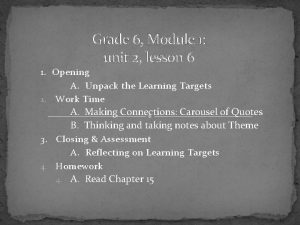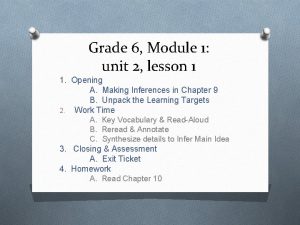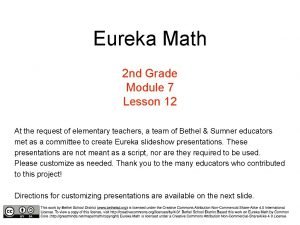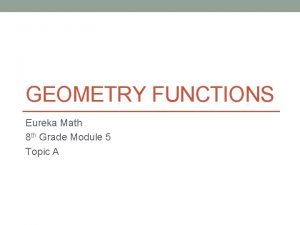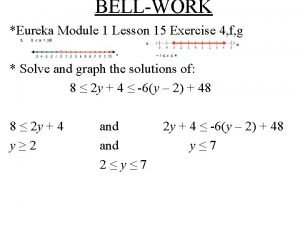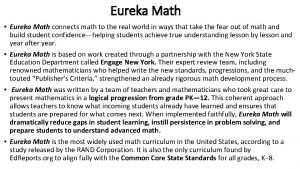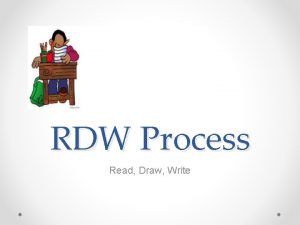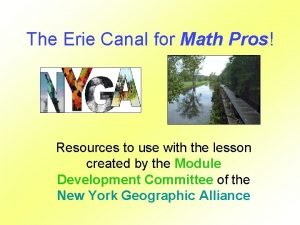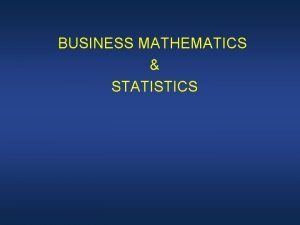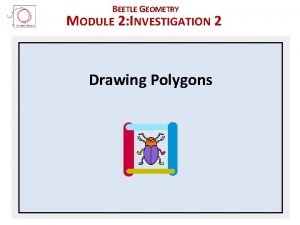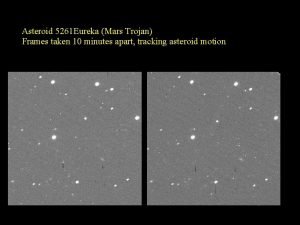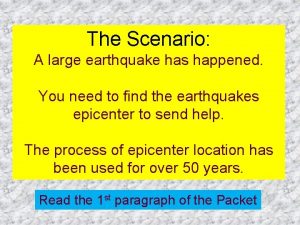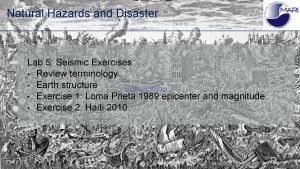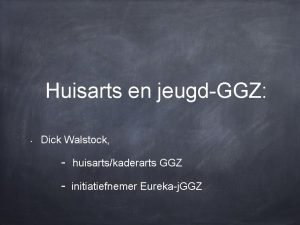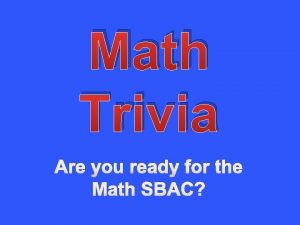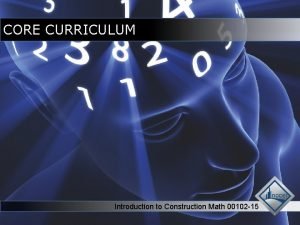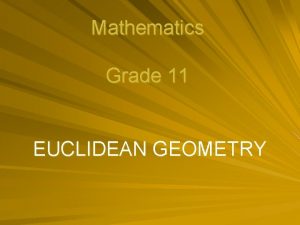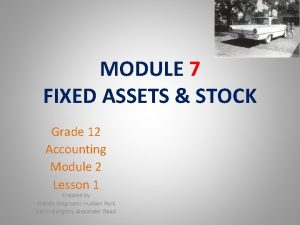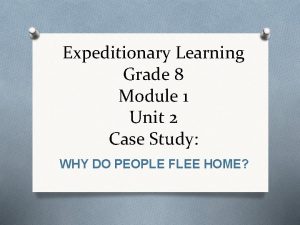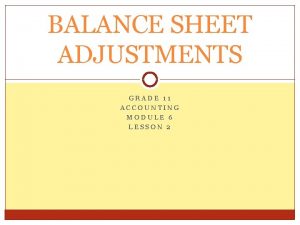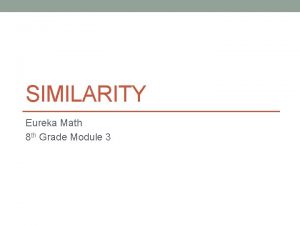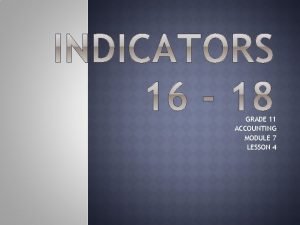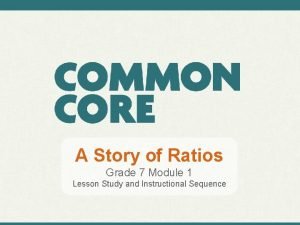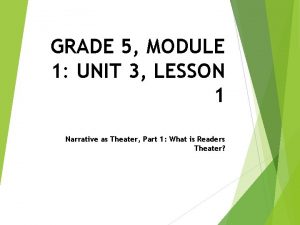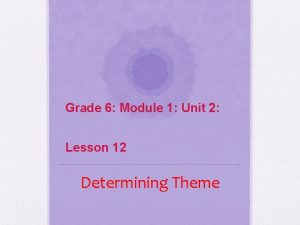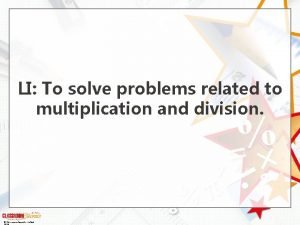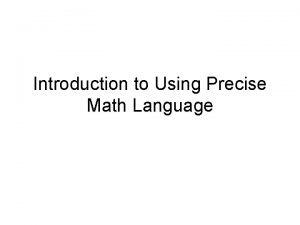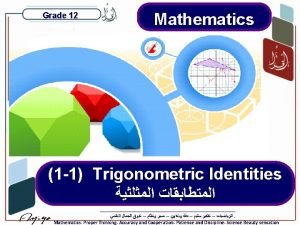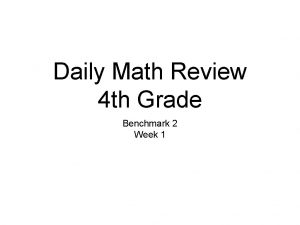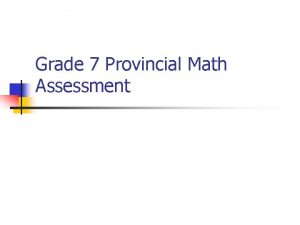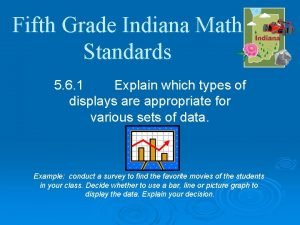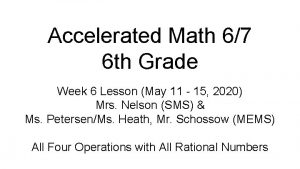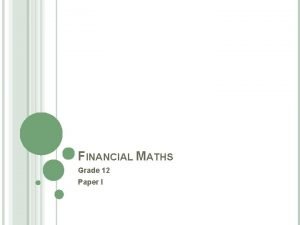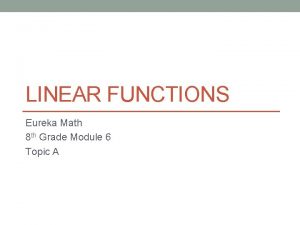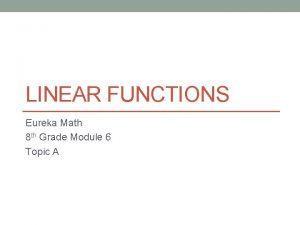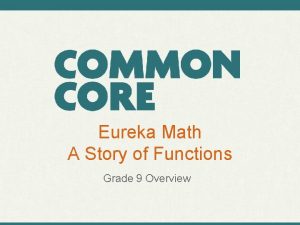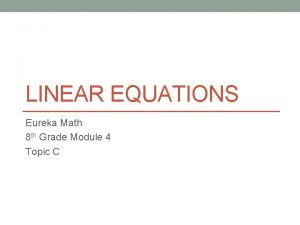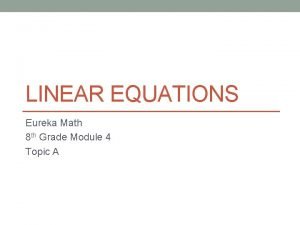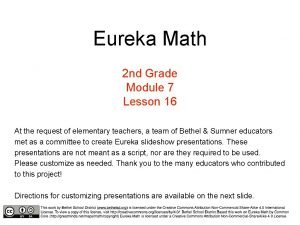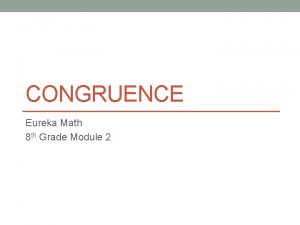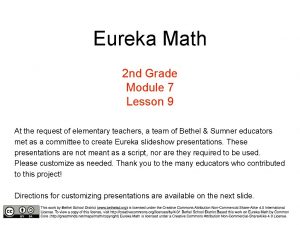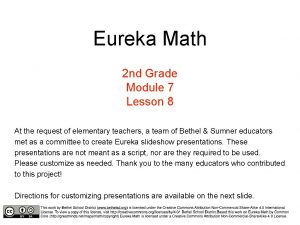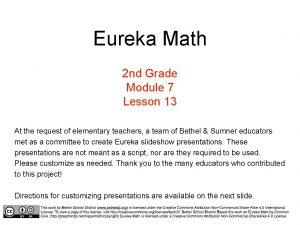GEOMETRY FUNCTIONS Eureka Math 8 th Grade Module











































































- Slides: 75

GEOMETRY FUNCTIONS Eureka Math 8 th Grade Module 5 Topic A

LESSON 1 Notes, examples(2), video, workshop

Notes – Functions •

Example 1 Suppose a moving object travels 256 feet in 4 seconds. Assume that the object travels at a constant speed. Write a linear equation for the situation and use it to predict how far the object has moved in the four times below.

Example 2 The object, a stone, is dropped from a height of 256 feet. It takes exactly 4 seconds for the stone to hit the ground. How far does it travel in the first 3 seconds? What about the last 3 seconds? Can we assume a constant speed?

Video http: //www. youtube. com/watch? v=Kr. X_z. Luw. Ovc

Example 2 The object, a stone, is dropped from a height of 256 feet. It takes exactly 4 seconds for the stone to hit the ground. How far does it travel in the first 3 seconds? What about the last 3 seconds? Can we assume a constant speed? 16 64 144 256

Example 2 The object, a stone, is dropped from a height of 256 feet. It takes exactly 4 seconds for the stone to hit the ground. How far does it travel in the first 3 seconds? What about the last 3 seconds? Can we assume a constant speed?

Workshop Must Do • Lesson 1 cw #1 -6 May Do • Khan academy • Independent work packet • Linear equation practice • Slope extra practice • PARCC tasks • Test rewrites

LESSON 2 Opener, notes, examples(1), workshop

Opening Shown below is the table from Example 2 of the last lesson and another table of values for the alleged motion of a second moving object. What do you NOTICE or WONDER?

Notes – Functions Function – a clearly defined rule that assigns each value of one quantity to exactly one value of a second quantity. Often times functions come with a formula (equation) but sometimes they are unclear or difficult to write. You need to be mindful of context when giving answers. Not all numeric answers make sense in the situation.

Opening Let’s formalize this “assigning. ” Like an input-output machine.

Notes – Functions •

Example •

Workshop Must Do May Do • Lesson 1 cw #1 -6 • Khan academy • Lesson 2 cw #1 -6 • Independent work packet • Linear equation practice • Slope extra practice • PARCC tasks • Test rewrites

LESSON 3 Opener, examples(4), workshop

Opening Is this a function? Is it linear?

Opening What’s the rule for this linear function? Notice the format: y=mx+b Does the table represent all inputs possible? What inputs are not possible/don’t make sense?

Example 1 - COPY Walter walks at a constant speed of 8 miles every 2 hours. Describe a linear function for the number of miles he walks in x hours. What is a reasonable range of x-values for this function?

Example 2 - COPY Veronica runs at a constant speed. The distance she runs is a function of the time she spends running. The function has the table of values shown below.

Example 3 – DON’T COPY Water flows from a faucet into a bathtub at the constant rate of 7 gallons of water pouring out every 2 minutes. The bathtub is initially empty, and its plug is in. Determine the rule that describes the volume of water in the tub as a function of time. If the tub can hold 50 gallons of water, how long will it take to fill the tub?

Example 3 continued – DON’T COPY Now assume that you are filling the same 50 -gallon bathtub with water flowing in at the constant rate of 3. 5 gallons per minute, but there were initially 8 gallons of water in the tub. Will it still take about 14 minutes to fill the tub?

Example 4 - COPY Water flows from a faucet at a constant rate. Assume that 6 gallons of water are already in a tub by the time we notice the faucet is on. This information is recorded in the first column of the table below. The other columns show many gallons of water are in the tub at different numbers of minutes since we noticed the running faucet.

Workshop Must Do May Do • Exit ticket #1 -2 • Khan academy • Lesson 3 cw #1 -5 • Independent work packet • Linear equation practice • Slope extra practice • PARCC tasks • Test rewrites

LESSON 4 Opener, vocab, examples(4), workshop

Opener vs

Notes – Vocabulary Function – a clearly defined rule that assigns each value of one quantity to exactly one value of a second quantity. Discrete – a function is restricted to whole values Not Discrete – when values are continuous (fractions ok) Linear – Constant rate of change between two variables Nonlinear – Not a constant rate of change between variables Domain – All possible input (x) values Range – All possible output (y) values

Example 1 – COPY b and f Classify each as discrete or not discrete a) The function that assigns to each whole number the cost of buying that many cans of beans in a particular grocery store. b) The function that assigns to each time of day on Wednesday the temperature of Sammy’s fever at that time. c) The function that assigns to each real number its first digit. d) The function that assigns to each day in the year 2015 my height at noon that day. e) The function that assigns to each moment in the year 2015 my height at that moment. f) The function that assigns to each color the first letter of the name of that color. h) The function that assigns the word YES to every yes/no question.

Example 2 – Don’t Copy •

Example 3 –Don’t copy •

Example 4 –Copy Consider the function that assigns to each of nine baseball players, numbered 1 through 9, his height. The data for this function is given below.

Workshop Must Do May Do • Exit ticket 1 -2 • Khan academy • Lesson 4 cw #1 -4 • Independent work packet • Linear equation practice • Slope extra practice • PARCC tasks • Test rewrites

BREAK PARCC warm up, workshop

Workshop Must Do Can Do • Complete classwork 1 -4 • Khan academy • Exit ticket 1 -3 • Algebra practice • Independent work packet • PARCC practice • Homework 1 -4

LESSON 5 Notes, examples(1 or 4), workshop

Notes – Vocabulary • The graph of a function is all the points (x, y) with x being an input for the function and y being its matching output • If a function has an equation, the graph of the function is the same as the graph of the equation, except only for valid values of the input • It is not possible for two different points of the graph to have the same x-coordinate (this would be one input, x, having two outputs, y).

Example – Try to Copy Which of these graphs are functions?

Workshop Must Do May Do • Exit ticket 2 -3 • Khan academy • Lesson 4 #1 -4 • Independent work packet • Lesson 5 cw #1 -4 • Linear equation practice • Slope extra practice • PARCC tasks • Test rewrites

LESSON 6 Opening, Review/Notes, examples(2), workshop, fluency

Fluency Set 1: Set 2:

Opener Which of these functions is linear? How do you know?

Notes – Recall SLOPE CONSTANT RATE OF CHANGE Y-INTERCEPT INITIAL VALUE FIXED AMOUNT (0, b) X=0

Example 1 –Copy This is a function. • Can it be described by a linear equation, y = mx + b ? • What will the graph look like? • How do you write the equation?

Example 2 –Copy • Is this a function? • Is it linear?

Workshop Must Do • Lesson 6 cw #1 -3 May Do • Khan academy • Independent work packet • Linear equation practice • Slope practice • Exponents review • PARCC tasks

LESSON 7 Fluency, Workshop, Discussion

Fluency

Workshop Must Do • Lesson 7 cw #1 -4 May Do • Khan academy • Independent work packet • Linear equation practice • Slope practice • Exponents review • PARCC tasks

Discussion • Was one style of presentation easier to work with over the others? Does everyone agree? • Was it easier to read off certain pieces of information about a linear function (its initial value, its constant rate of change, for instance) from one presentation of that function over another?

LESSON 8 Reminder, Workshop

Recall - Linear Functions SLOPE CONSTANT RATE OF CHANGE Y-INTERCEPT INITIAL VALUE FIXED AMOUNT • Linear functions have a constant rate of change • Nonlinear functions don’t

Linear Functions GRAPH TABLE Slope-Intercept EQUATION WORDS Standard Form EQUATION SLOPE Y-INTERCEPT

Workshop Must Do May Do • Lesson 7 cw #1 -4 • Khan academy • Lesson 8 cw #1 -10 • Independent work packet • Exit ticket 7 -8 • Linear equation practice • Slope practice • Exponents review • PARCC tasks

GEOMETRY FUNCTIONS Eureka Math 8 th Grade Module 5 Topic B

LESSON 9 Notes, Examples(2), workshop

Notes – part 1 Area– the space inside a 2 -dimensional figure Perimeter - the distance around a 2 -dimensional figure Volume - the space inside a 3 -dimensional figure Composite figure - a figure made up of 2 or more traditional shapes joined by their sides/edges

Notes – Formulas Perimeter of rectangles/parallelograms: Perimeter of squares: Circumference of Circle: Area of rectangles/parallelograms: Area of Squares: Area of triangles: Area of Circles: Volume of rectangular prism: Volume of cube:

Example 1 –Copy 1) What is the side length of the smaller, inner square? 2) What is the area of the smaller, inner square? 3) What is the length of the larger, outer square? 4) What is the area of the larger, outer square? 5) What is the area of the 1 -inch border?

Example 2 –Copy w = 4 cm h = 4 cm V = 300 cm 3 w = 3 cm L = 10 cm What is the volume of this prism? L = 15 cm What is the height of the prism?

Workshop Must Do May Do • Exit ticket 7 & 8 • Khan academy • Lesson 9 cw #1 -9 • Independent work packet • Linear equation practice • Slope practice • Exponents review • PARCC tasks

LESSON 10 Opening, Notes, Example, workshop

Opening Write an equation to determine the volume of these figures.

Don’t know HOW to calculate the area of the base, but the volume would still be Bh.

http: //youtu. be/0 ZACAU 4 SGy. M Since it took 3 cones to fill the cylinder, the volume is 1/3 that of a cylinder with the same base.

Notes – Volume of upright figures is found but calculating the area of the base, B, and multiplying it by the height. Volume of rectangular prism: Volume of cube: Volume of cylinder: Volume of cone: Diameter – distance all the way across circle Radius – distance from center to outside of circle; half diameter

Example Write an equation to determine the volume of these figures.

Workshop Must Do May Do • Lesson 10 cw #1 -5 • Khan academy • Lesson 9 cw #1 -9 • Independent work packet • Linear equation practice • Slope practice • Exponents review • PARCC tasks • Complete all cw and hw • Notes sheet • Folder organize

LESSON 11 Opening, Notes, Example, workshop

Opener Archimedes, Zu Chongshi & Zu Geng, Cavalieri http: //www. youtube. com/watch? v=a. Ly. Qddy. Y 8 ik

Sphere •

Notes – Volume of upright figures is found but calculating the area of the base, B, and multiplying it by the height. Volume of rectangular prism: Volume of cube: Volume of cylinder: Volume of cone: Volume of sphere: or

Example 1 - Copy Compute the volume of the sphere. Leave your answer in terms of pi. Use 3. 14 for pi.

Example 2 – Copy (JUST LIKE TEST Q) A cylinder has a diameter of 16 inches and a height of 14 inches. What is the volume of the largest sphere that fits inside? Leave your answer in terms of pi. Use 3. 14 for pi.

Workshop Must Do • Lesson 11 cw #1 -6 May Do • Khan academy • Independent work packet • Linear equation practice • Slope practice • Exponents review • PARCC tasks • Complete all cw and hw • Notes sheet • Folder organize
 Grade 8 module 1 unit 1 lesson 6 answer key
Grade 8 module 1 unit 1 lesson 6 answer key Eureka math grade 6 module 1 lesson 1
Eureka math grade 6 module 1 lesson 1 Eureka math 3rd grade module 7
Eureka math 3rd grade module 7 Is it linear
Is it linear Eureka math algebra 1 module 1 lesson 15
Eureka math algebra 1 module 1 lesson 15 Eureka math algebra 1 module 4
Eureka math algebra 1 module 4 Eureka math 9th grade
Eureka math 9th grade Rdw process in math
Rdw process in math Eureka math teks edition
Eureka math teks edition Pros and cons of the erie canal
Pros and cons of the erie canal Place value chart eureka math
Place value chart eureka math Proportion in business
Proportion in business Lewis structures and molecular geometry
Lewis structures and molecular geometry 4 electron domains 2 lone pairs
4 electron domains 2 lone pairs Molecular geometry and bonding theories
Molecular geometry and bonding theories Geometry module 2
Geometry module 2 C device module module 1
C device module module 1 Eureka npc
Eureka npc Eureka asteroid
Eureka asteroid Elko, nv seismic station s-p interval = seconds
Elko, nv seismic station s-p interval = seconds Salitang balbal
Salitang balbal Eureka puc pr
Eureka puc pr King georges hostel
King georges hostel Elzab eureka
Elzab eureka Isipadu air yang disesarkan
Isipadu air yang disesarkan Eureka eurostars eligibility
Eureka eurostars eligibility Eureka recherche documentaire
Eureka recherche documentaire Eureka, ca seismic station s-p interval = seconds
Eureka, ca seismic station s-p interval = seconds Seretide eureka
Seretide eureka Eureka programa
Eureka programa Eureka uqam
Eureka uqam Eureka
Eureka Huisarts eureka
Huisarts eureka Eureka european commission
Eureka european commission Aranesp eureka
Aranesp eureka Geometry math trivia
Geometry math trivia 00102-15
00102-15 Tan chord theorem
Tan chord theorem Number sentence
Number sentence Grade 9 english module 4 answer key
Grade 9 english module 4 answer key Principles of marketing grade 11 module 2
Principles of marketing grade 11 module 2 Fixed assets accounting grade 12
Fixed assets accounting grade 12 Grade 8 module 1
Grade 8 module 1 Grade 11 accounting module 1
Grade 11 accounting module 1 Grade 8 module 3
Grade 8 module 3 Accounting module grade 11
Accounting module grade 11 Module 1 grade 7
Module 1 grade 7 English module grade 10
English module grade 10 Story of units grade 2
Story of units grade 2 Grade 5 module 1 lesson 1
Grade 5 module 1 lesson 1 Reading and writing grade 11 module 6
Reading and writing grade 11 module 6 Grade 6 module 1: unit 2 answer key
Grade 6 module 1: unit 2 answer key English module grade 10 unit 3
English module grade 10 unit 3 Math game math hit the button
Math game math hit the button Domain and range
Domain and range Math 3rd grade jeopardy
Math 3rd grade jeopardy Hcpss gifted and talented
Hcpss gifted and talented 3rd grade staar blueprint
3rd grade staar blueprint Comparison statement 4th grade math
Comparison statement 4th grade math The language of mathematics is precise meaning
The language of mathematics is precise meaning Eqao practice test grade 3
Eqao practice test grade 3 Cofunction identities
Cofunction identities 3/8 divided by 13/16
3/8 divided by 13/16 4th grade math jeopardy common core
4th grade math jeopardy common core Cell phone tariffs grade 10
Cell phone tariffs grade 10 Grade 7 provincial math assessment
Grade 7 provincial math assessment Indiana state standards math
Indiana state standards math Grade 7 maths project
Grade 7 maths project Next gen math standards
Next gen math standards Scale in mathematical literacy
Scale in mathematical literacy Math 6th grade
Math 6th grade Place value jeopardy 5th grade
Place value jeopardy 5th grade Oklahoma state department of education standards
Oklahoma state department of education standards Science jeopardy 7th grade
Science jeopardy 7th grade Interactive math notebooks 6th grade
Interactive math notebooks 6th grade Grade 12 financial maths summary
Grade 12 financial maths summary
